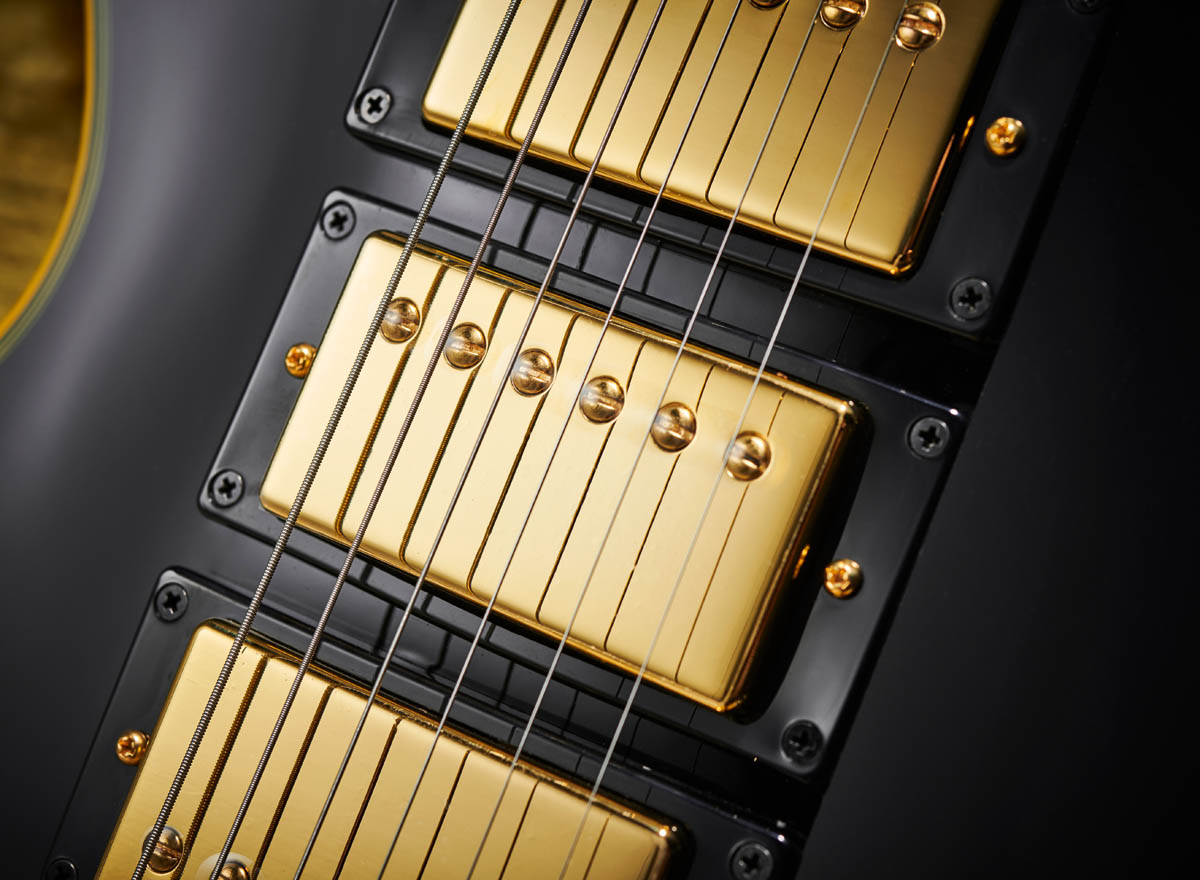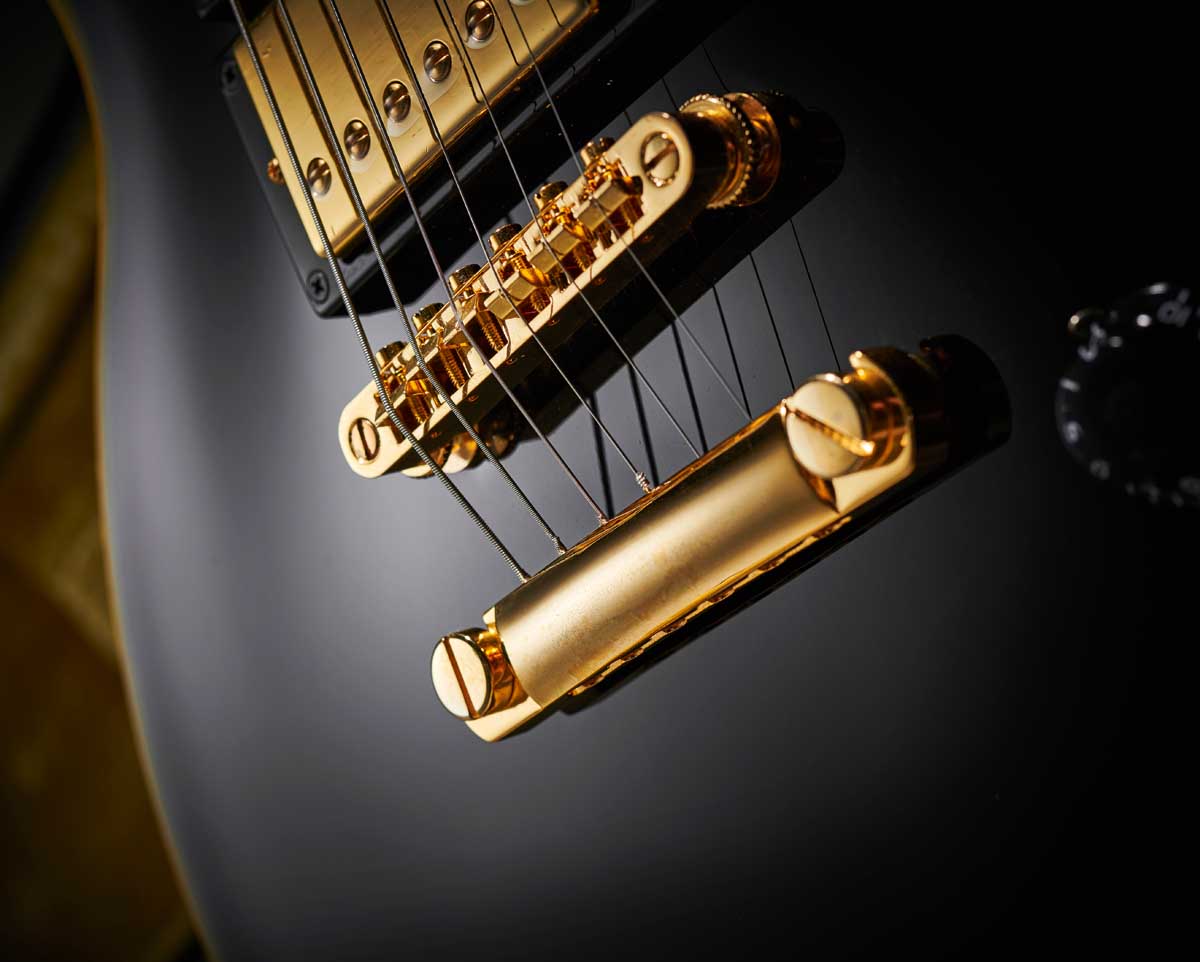Guitar World Verdict
Joe Bonamassa's Epiphone Black Beauty is more than just a looker, with its three-pickup format offering a huge range of tones – it has a feel that is authentic in terms of period and worthy of the name on the headstock.
Pros
- +
Very tidy build.
- +
Vintage-specific neck.
- +
Fulsome PAF-alike sounds and unique mixed-position voice.
Cons
- -
More expensive than the standard twin-pickup model, but we don’t feel short-changed.
You can trust Guitar World
Epiphone’s latest Joe Bonamassa tie-up, based on his three-pickup Les Paul Custom circa 1958, certainly comes across as a very complete package. It has vintage credentials, a great backstory, comes with a very tidy case and, oh, looks great! But it’s far from style over substance and is another reminder of the ever-increasing quality of the Asian-built electric guitar.
The original Custom recipe is replicated here. This guitar is all mahogany with an ebony fingerboard. While it’s actually slightly lighter than Joe’s original, it’s chunky and weighty; there’s no weight relief and it’s well in line with numerous modern single-cuts we’ve tested.
Of course, we’re not talking nitro finish, but the standard poly is perfect. It’s beautifully contrasted by the amber-tinted binding to the top and back of the body with multi-ply inner purfling, and single-ply binding to the fingerboard and headstock, which, incidentally, is pitched at a slighter angle than the classic 17 degrees.
The new-regime, more Gibson-style headstock outline is pretty cool in our book, too, as are the very tidy pearloid block inlays. We haven’t played a note and we’re falling for this one already…

While the tune-o-matic and stud tailpiece appear pretty generic-looking, they employ Epiphone’s LockTone system, which means both parts clip to their posts and won’t fall off during a string change. Whether or not they improve sustain, as claimed, might be difficult to determine, but as we’ll find out this is a guitar that certainly doesn’t lack in that department.
The unusual and very retro tuners, which have appeared on previous Epiphone Masterbilt models, might seem an odd choice here, but the originals were actually stock on Bonamassa’s ’58 Gibson. They have domed backs and pretty chunky buttons, but are smooth enough in use, and do contribute to a very stable guitar, tuning wise.
The Graph Tech NuBone nut is extremely well cut, too, and if we’re honest we’ve had more tuning issues with some contemporary Gibsons. A trio of gold-covered ProBuckers (2s in the neck and middle, and a 3 at the bridge) contribute to the opulent gold/black theme.
All the latest guitar news, interviews, lessons, reviews, deals and more, direct to your inbox!
The PAF-style ProBuckers appeared around 2013 and have had consistently good feedback, but another twist here is the control circuit components, which are more like you’d find on a Gibson USA production Les Paul.

Feel & Sounds
If you like your necks big with a rounded profile, you’ll be right at home here. This beast has a depth of 23.1mm at the 1st fret – which, to put into perspective, is the depth at the 12th fret of the Fender American Pro IIs on review elsewhere in this issue.
That full, rounded feel in the lower positions just gets bigger, touching 26mm as the 12th fret area flows into the neck heel. The fret gauge is pretty regular medium jumbo (approximately 2.69mm wide by 1.1mm high), and the frets themselves sit tidily over the edge binding, although they could do with just a little more smoothing if we’re being picky, as there’s a slightly scratchy feel on bends.
As supplied, setup is pretty mainstream, but is 1.5mm on the treble side at the 12th fret and edging 2mm on the bass side. It’s a muscular-feeling, weighty guitar, but even before you plug in there’s a really inviting smooth yet vibrant response.
Firstly, this is a different-sounding Les Paul thanks to that middle pickup. You can’t voice it on its own, just in tandem with the bridge pickup when the toggle selector switch is in middle position.
The downside is that the classic bridge and neck mix position of a two-pickup Les Paul – where you can subtly shape so many benchmark sounds – isn’t here. Instead, what we have is a frankly more Fender-y mix, if a little thicker, with an almost cocked-wah-like honk that, along with the bridge pickup, gives a relatively bright voicing to what many would consider a ‘dark’-sounding Les Paul.

It’s actually quite a good balance of depth, clarity and power, perfect for classic blues/rock styles without sounding over-thick or one dimensional. And that’s just the bridge pickup. That said, the volume does soften the attack as it’s reduced perhaps a little too much, and we’d be tempted to consider a treble bleed, certainly for those more diverse function-style gigs.
With its period-style neck and good weight it not only feels substantial but sounds it, too
The neck pickup alone might be the sole reason to buy this affordable ’Paul. It’s a big voice, but there is clarity. Pull the volume and tone back and clean up your amp and there’s plummy jazz; pull the tone back up and it’s a slightly rounded voice that loves a little more crunch; then wind it back up to full for your moodier blues and rock leads.
As is, the third pickup doesn’t bring anything more to the table than a dual-pickup version, but there is quite a particular character to the voicing here.
With a cranked Marshall, this lowly Custom holds its own when compared to a Gibson Les Paul Classic with Burstbuckers I and II, and our modded and stripped Tokai with Cream T Bangers – less scooped with less high-end sizzle with the controls maxed out.
What we’re hearing is a slightly smoother and rounded nose to the note attack and a little more midrange push. Now, whether you put that down to the construction, pickups – whatever – it’s a viable and attractive voice.


Verdict
Many of us can be sniffy about low-cost lookalikes, but this one was a genuine surprise. Aside from the fact it’s one of the coolest-looking Les Pauls ever, with its period-style neck and good weight it not only feels substantial but sounds it, too.
It’s about that illusive character, reflected by the modded mixed position voice, which fixes the original style and provides a different voice that is bookended by very credible bridge and neck sounds that really punch above the price point.
Yes, it slots in at the top of the Epiphone range in price, but, like we say, it’s a good package that stands out in a crowded market. Time to re-evaluate Epiphone? On this evidence, most definitely. And with Mr Bonamassa’s guitar collection ever-growing, we can only wonder what’s next.
Specs

- PRICE: $799 / £749 (inc case)
- ORIGIN: China
- TYPE: Single-cutaway, solidbody electric
- BODY: Mahogany (non weightrelieved)
- NECK: Mahogany, 50s profile, glued-in
- SCALE LENGTH: 628mm (24.75”)
- NUT/WIDTH: Graph Tech NuBone/ 43.07mm
- FINGERBOARD: Bound ebony, pearloid block markers, 305mm (12”) radius
- FRETS: 22, medium/jumbo
- HARDWARE: Epiphone LockTone tune-o-matic bridge and stud tailpiece, vintage-style Epiphone Historic tuners – gold-plated
- STRING SPACING, BRIDGE: 51.5mm
- ELECTRICS: Epiphone ProBucker 2 humbuckers (neck and middle), ProBucker 3 (bridge), 3-way toggle pickup selector, 2x volumes, 2x tones
- WEIGHT (kg/lb): 4.23/9.3
- OPTIONS: None
- RANGE OPTIONS: The standard 2-pickup Epiphone Custom, in black or white, with Slim Taper neck and a gigbag costs $679 / £599
- LEFT-HANDERS: Not this model
- FINISH: Ebony (as reviewed)

Dave Burrluck is one of the world’s most experienced guitar journalists, who started writing back in the '80s for International Musician and Recording World, co-founded The Guitar Magazine and has been the Gear Reviews Editor of Guitarist magazine for the past two decades. Along the way, Dave has been the sole author of The PRS Guitar Book and The Player's Guide to Guitar Maintenance as well as contributing to numerous other books on the electric guitar. Dave is an active gigging and recording musician and still finds time to make, repair and mod guitars, not least for Guitarist’s The Mod Squad.

